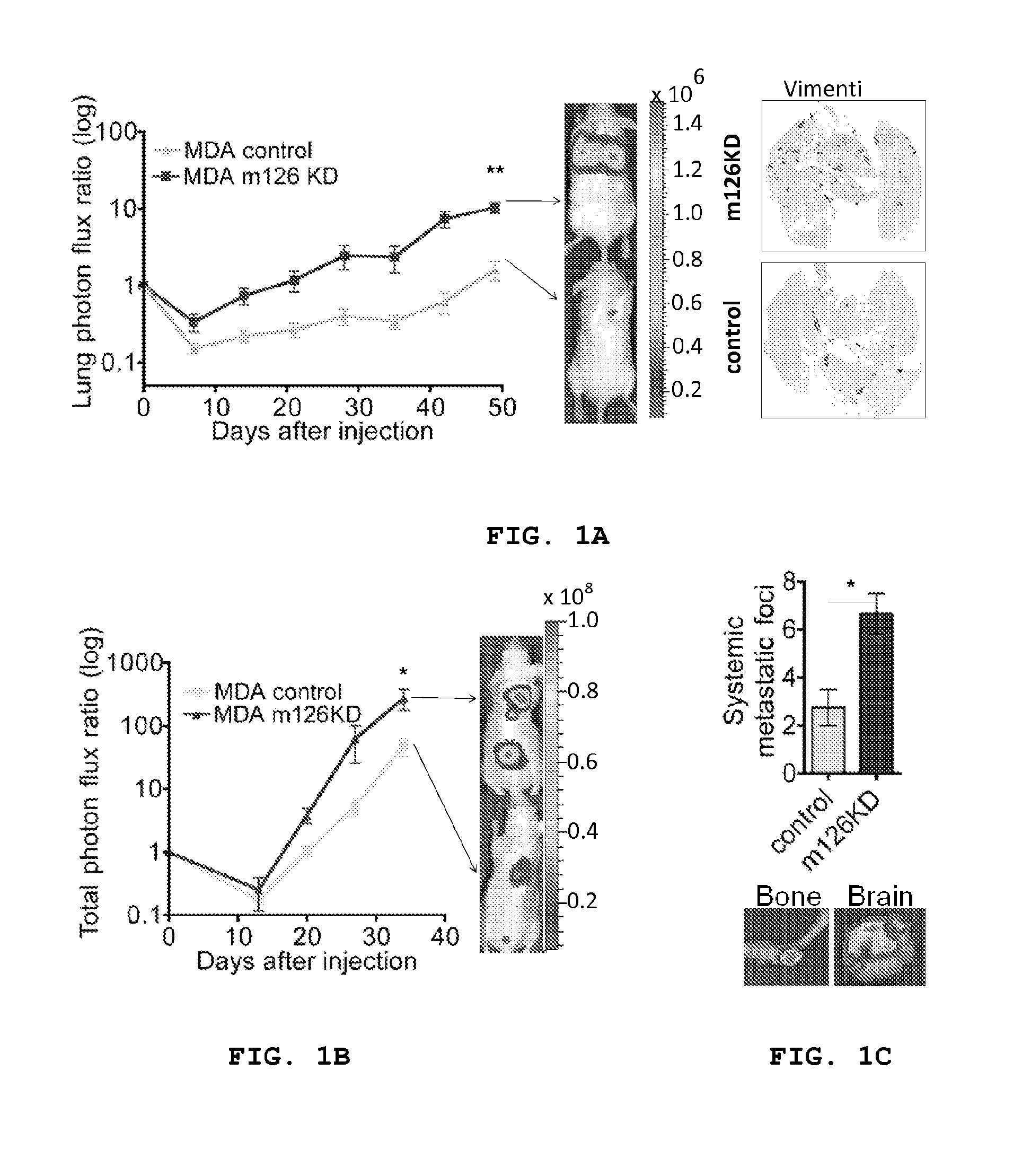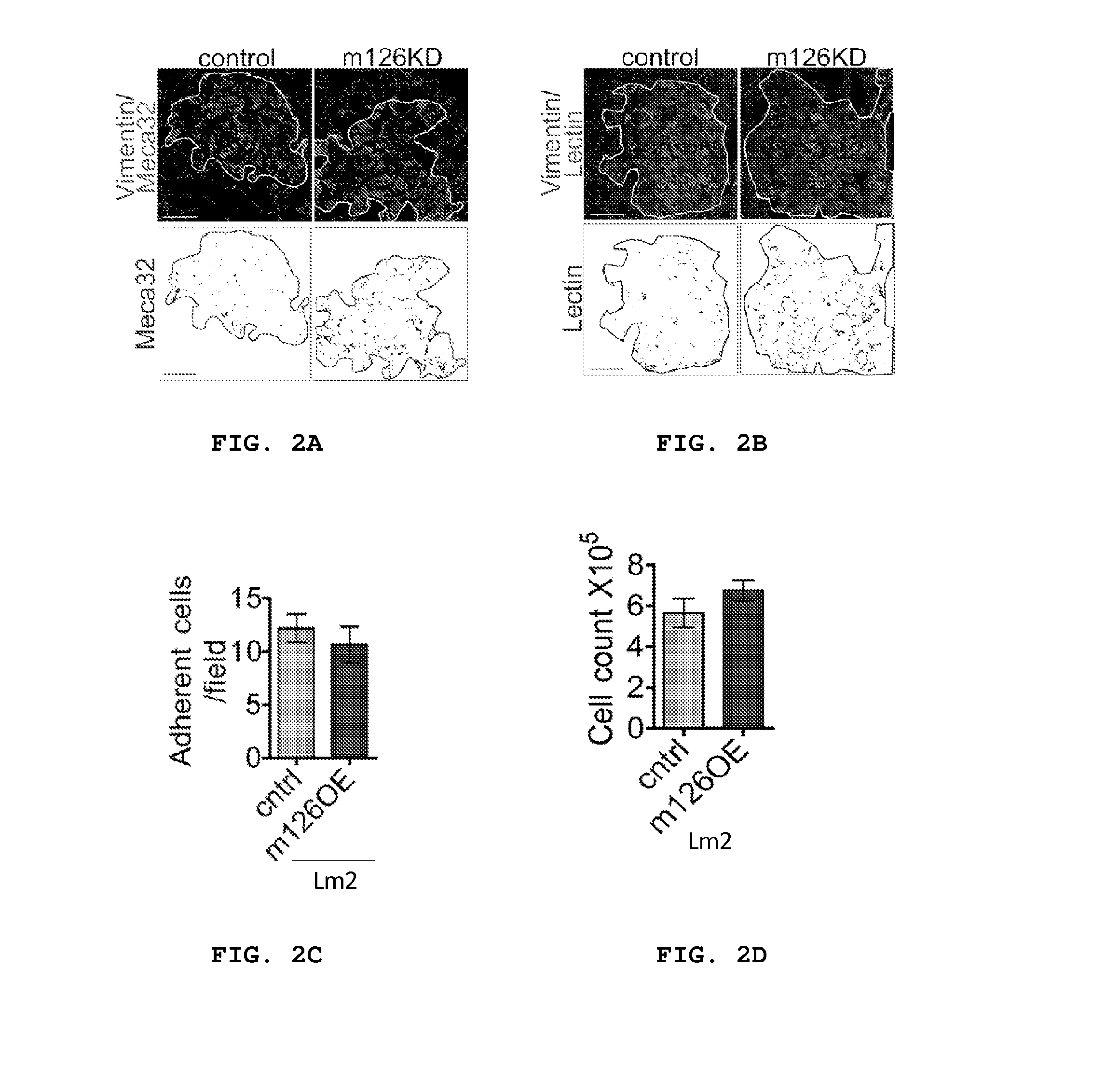Treatment of angiogenesis disorders
a technology for angiogenesis and disorders, applied in the field of angiogenesis disorders, can solve the problems of ineffective adjuvant treatment of metastasis, limited success, and daunting clinical challenges, and achieve the effects of inhibiting endothelial recruitment, high affinity, and inhibiting the recruitmen
- Summary
- Abstract
- Description
- Claims
- Application Information
AI Technical Summary
Benefits of technology
Problems solved by technology
Method used
Image
Examples
example 1
Methods and Materials
[0107]This example describes general methods and materials used in Examples 2-8.
[0108]Cell Culture
[0109]All cell lines were propagated as described in Tavazoie, S. F. et al., Nature 451 (7175), 147 (2008). 293T cells were cultured with DMEM media supplemented with 10% FBS; H29 cells were cultured with DMEM media supplemented with 10% FBS, 20 ng / mL doxycycline, 2 μg / mL puromycin, and 0.3 mg / mL G418; and HUVEC cells were cultured with EGM-2 media (CC-3162, Lonza, Basel, Switzerland). The MDA-MB-231 and CN34 breast cancer cell line and its metastatic derivatives LM2, BoM2 and Lm1a are described in Minn, A. J. et al., Nature 436 (7050), 518 (2005).
[0110]Animal Studies
[0111]All animal work was conducted in accordance with a protocol approved by the Institutional Animal Care and Use Committee (IACUC) at The Rockefeller University. Age-matched female NOD / SCID mice (6-8 week old) were used for both orthotopic mammary fat pad tumor initiation assays (Minn, A. J. et al., ...
example 2
Endogenous Mir-126 Suppressed Systemic Metastatic Colonization
[0149]In this example, assays were carried out to analyze metastatic progression in the setting of miR-126 loss-of-function. This enabled one to compare in vivo metastatic events between control and miR-126 knockdown (KD) cells and to reveal the influence of endogenous miR-126 on metastatic colonization.
[0150]A MDA-231 breast cancer cell line was generated in which miR-126 was stably knocked down (94% knock down; FIG. 7) using the miR-Zip anti-sense hairpin microRNA inhibition system. miR-126 KD and control KD cells were injected into immunodeficient mice and evaluated for metastatic colonization capacity in tail-vein colonization assays. miR-126 silencing in poorly metastatic cells increased lung metastatic colonization by 4.2 fold (P=0.0073) as assessed by quantitative bioluminescence imaging (FIG. 1a) and dramatically increased metastatic colonization on gross histology (FIG. 1a). Intracardiac injection of MDA miR-126 ...
example 3
miR-126 Suppresses Metastatic Endothelial Recruitment by Breast Cancer Cells
[0154]The above findings suggest that miR-126 silencing can provide metastatic cells and incipient metastases an advantage during metastatic colonization. While considering the basis of this advantage, it was noted that miR-126 knockdown metastases displayed higher vessel densities on microscopic visualization of lung H&E tissue sections. To quantify this, co-immunostaining was performed for human vimentin, which labels MDA-231 breast cancer cells, and the endothelial marker MECA-32, which allowed one to quantify the endothelial density within metastatic nodules in lungs of mice injected with either control or miR-126 KD breast cancer cells. Image analysis and quantification revealed metastases derived from miR-126 KD cells to have a significantly higher endothelial density (FIG. 2a; 35% increase; P=0.02).
[0155]To determine if the enhanced endothelial density in miR-126 KD metastases represents functional ve...
PUM
 Login to View More
Login to View More Abstract
Description
Claims
Application Information
 Login to View More
Login to View More - R&D
- Intellectual Property
- Life Sciences
- Materials
- Tech Scout
- Unparalleled Data Quality
- Higher Quality Content
- 60% Fewer Hallucinations
Browse by: Latest US Patents, China's latest patents, Technical Efficacy Thesaurus, Application Domain, Technology Topic, Popular Technical Reports.
© 2025 PatSnap. All rights reserved.Legal|Privacy policy|Modern Slavery Act Transparency Statement|Sitemap|About US| Contact US: help@patsnap.com



